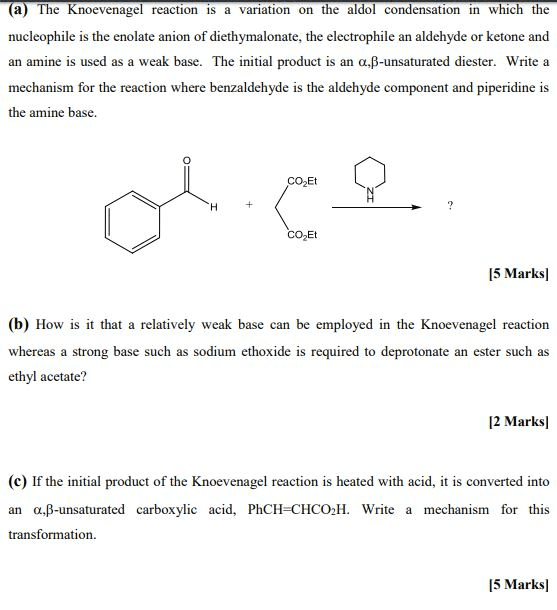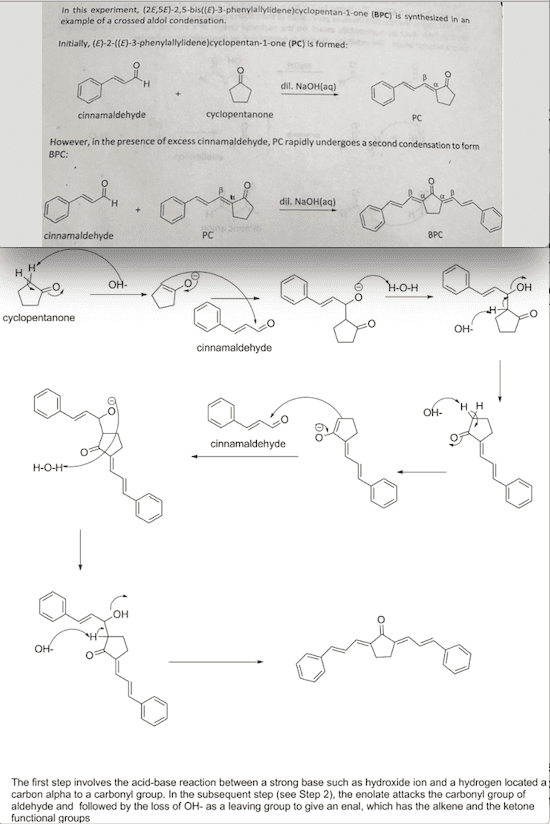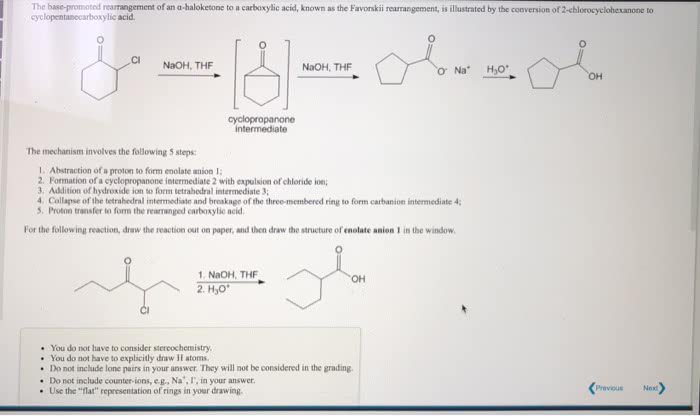CHM 2123 Study Guide - Final Guide: Haloform Reaction, Acetophenone, Benzaldehyde

Lab #6 – Reactions of Carbonyls Under Basic Conditions
Introduction
This experiment will be done in two parts; in the first part, benzalacetophenone
will be prepared by combining acetophenone and benzaldehyde with NaOH. An aldol
condensation will be done by the removal of the first α-proton by a base to generate an
enolate, which will attach the carbonyl of the second molecule (the electrophile).
Abstraction of a second α-proton in a protic solvent will lead to elimination of the
hydroxyl group and formation of the α,β-unsaturated product.
In this experiment, benzalacetophenone (1,3-diphenyl-2-propen-1-one) will be
formed by cross-condensation of acetophenone (1-phenylethanone) and benzaldehyde
after dehydration. This occurs when the two carbonyl compounds react with each other,
with one reacting as an enolate (the nucleophile) and the other reacting as an electrophile.
NaOH will be used as the base in this reaction, with very little secondary products
forming since the self-condensation of acetophenone is very slow. Benzaldehyde also
cannot self-condense because it does not possess any α-protons.
In the second part of the experiment, a haloform reaction will be performed with
sodium hypochlorite (NaOCl). The oxygen atom on NaOCl is more electronegative than
the chlorine atom and therefore, makes it an excellent source of electrophilic halogens.
The α-haloketone is formed when the enolate reacts with hypochloride at the α-carbon of
the enolate and it becomes increasingly acidic because of inductive effects. This reaction
occurs until α,α,α –trihaloketone is formed after deprotonation by NaOCl. An acid-base
reaction transforms the carboxylic acid into a carboxylate after the nucleophilic attack by
the hydroxide of the carbonyl, yielding the haloform CHX3. This is an example of an
addition-elimination process: the nucleophilic attack of the carbonyl forming a tetrahedral
intermediate is followed by the departure of the leaving group (-CX3).
find more resources at oneclass.com
find more resources at oneclass.com

Table of Reagents
Compound
Mol.
Mass
(g/mol)
Quantity
(mL)
Density
(g/cm3)
Mmol
Equivalents
EtOH
46.1
4.00
789
-
NaOH
40.0
4.00
2.13
0.213
31.5
Acetophenone
120
2.00
1.03
0.0171
2.53
Benzaldehyde
106
1.00
1.04
0.00981
1.45
NaOCl
74.4
40.0
1.11
0.597
88.3
Acetone
58.1
0.500
0.785
0.00676
1.00
HCl
36.5
0.200
1.49
0.00816
1.21
Experimental Procedure
Refer to CHM2123 lab manual, experiment 4, p.76 – p.77.
Observations
Key Step
Observation
Part A: combined acetophenone and
benzaldehyde with 10% NaOH solution
and EtOH after 45 minutes
- Solution is a cloudy yellow colour
Part A: solution is put into an ice bath
- Solution starts to become more cloudy
and white
- Precipitate is visible at the bottom of
the flask
Part A: filtered the solution to obtain the
crystals
- Crude product is yellow with big hard
crystals
Part A: solution is left at room temperature
and then put into an ice bath
- Precipitate becomes visible at the bottom
of the flask when left in the ice bath for 5
minutes
Part A: filtered the solution after
recrystallization
- Purified product is a pale yellow colour,
with big hard crystals
Part B: boiled the acetophenone and
NaOCl for 25 minutes
- Solution is a slight yellow colour at first
(from the bleach solution)
- After being heated for 25 minutes, the
solution starts to lose its colour and
turns transparent
Part B: addition of concentrated HCl
- Solution becomes cloudy and precipitate
starts to form in the flask
- White precipitate is visible and takes
up more than half the content of the flask
Part B: filtered the final solution
- Final product is a white powder like
find more resources at oneclass.com
find more resources at oneclass.com
Document Summary
Lab #6 reactions of carbonyls under basic conditions. This experiment will be done in two parts; in the first part, benzalacetophenone will be prepared by combining acetophenone and benzaldehyde with naoh. An aldol condensation will be done by the removal of the first -proton by a base to generate an enolate, which will attach the carbonyl of the second molecule (the electrophile). Abstraction of a second -proton in a protic solvent will lead to elimination of the hydroxyl group and formation of the , -unsaturated product. In this experiment, benzalacetophenone (1,3-diphenyl-2-propen-1-one) will be formed by cross-condensation of acetophenone (1-phenylethanone) and benzaldehyde after dehydration. This occurs when the two carbonyl compounds react with each other, with one reacting as an enolate (the nucleophile) and the other reacting as an electrophile. Naoh will be used as the base in this reaction, with very little secondary products forming since the self-condensation of acetophenone is very slow.



